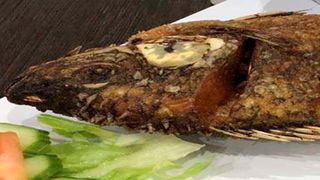
Deep fried tilapia.
| File | Nation Media GroupNews
Premium
Lake vs pond fish: How to tell an ‘original’ tilapia from a ‘fake’ one
What you need to know:
- The predominant fish in the scale of consumption has always been tilapia among the fresh water catch.
- Tilapia is the main culinary show that a visitor to Kisumu has to sample to stamp the fact that he was in the lakeside city.
A street adage asserts: ‘Never sniff a gift fish…’ It is a form of showing gratitude and manners at not denigrating what you receive with doubt. That seems to have been forgotten in the show of expertise on knowledge of fish.
Times have changed and fish is now a delicacy for many who hitherto never gave it a thought on their plate.
The predominant fish in the scale of consumption has always been tilapia among the fresh water catch.
The rise in popularity of this fish is now being dogged by a debate on the ‘original’ tilapia and other ‘variants’.
Everyone seems to have become a connoisseur of this delicacy.
Popularly known as ‘Ngege’ in the local Luo dialect, its larger varieties are called ‘Nyamami’. Tilapia is the main culinary show that a visitor to Kisumu has to sample to stamp the fact that he was in the lakeside city.
A fish meal from the world’s second largest fresh water lake without doubt, leaves one salivating and asking for more.
Imported fish from China
But just how do you tell whether the fish you are having is straight from the lake, from the pond or China? That is the essence of the argument that rages.
Some say the difference lies in the taste. Others claim it is the physical appearance that tells them apart.
This is the dilemma fish lovers in the country have been grappling with ever since the government approved fish imports from China more than three years ago, and empowered fishermen to engage in aquaculture through ponds and cages in the lake.
In 2018, the flooding of Chinese fish in local markets sparked some diplomatic unease between Nairobi and Beijing when President Uhuru Kenyatta asked agriculture officials to find ways of curtailing the imports.
The move was aimed at protecting local fishermen from foreign exploitation. The favourite of many is tilapia from the lake. Those from the cages, ponds and China are pretenders, as far as they are concerned.
We tried to establish some things you could look out for to identify the ‘real’ tilapia. Fish from the pond and cages is normally darker than the usual silver grey tilapia from the lake.
Ms Maurine Odira gets her fish from Homa Bay County and transports them to Nairobi.
Soft and spongy
“Lake fish has red pigments. It has a longer tail, while those from the pond are dark grey. With Chinese tilapia, its scales are lighter,” she says.
Ms Jackline Nyaboro, another trader, adds: “Pond fish is darker. There’s also size. Pond fish are similar in size, while those from the lake vary.”
Mr Bernard Omondi, the chairperson of the fresh fish market, however, says “no one can tell the difference”.
Ms Mary Adhiambo, a Kisumu resident, says Chinese imports are soft, and usually “spongy”.
Ms Sarah Odongo, a trader, adds: “The intestines of the Chinese fish are unusually harder.”
Some fishermen say fish from the pond has the smell of mud.
Ms Bella Aswa Makokha, a Kisumu resident, says the soup of lake fish is white and thicker than the others.
Mr Geoffrey Osego, another resident, says Chinese fish is “a little bitter” and has very strong bones, even after deep frying.
Dr Christopher Aura, the Director of Fresh Water Systems at Kenya Marine and Fisheries Research Institute (Kemfri), says organoleptic analysis on any food will determine the smell, texture, firmness and tasting.
All these produce varied opinions and could even confuse fish vendors.
The analysis are tests conducted to determine if food or pharmaceutical products can transfer tastes to the materials and components they are packaged in.
Dr Aura says one of the determinants on how a fish looks like is the biological appearance, which is genetically inherited from its parents.
Second is the fish environment, which could determine the colour of the scales or other parts of the body.
Appearance and taste
“The environment includes the feeds given to the fish, which can affect the size or the smell. A lake fish might have just eaten planktons moments before it’s fished,” he says.
The process involved from the time of harvesting to the time the fish is packaged also determines its appearance and taste.
When lake fish is exposed out of water for a long time, it changes in texture and colour from silver to dark grey. But that doesn’t make it pond fish.
“Some of these descriptions are given by vendors and fishermen with commercial interests attached because they would not want to be linked with fish from certain habitats. Let everyone differentiate between perception and science in making judgments,” says Dr Aura.
A carton of fish goes for between Sh2, 000 and Sh2,500 with the 10kg one carrying 60 pieces of tilapia, each weighing between 200-300 grams.
This means a piece of imported tilapia costs Sh30 or Sh40 in the market, way cheaper than the local variety that costs between Sh100 and Sh200. Dr Aura says the only way to tell the origin of fish is by tracing it from the source.
I hope you won’t be quick to pass judgment the next time you sit at the dining table for steamed fish.





